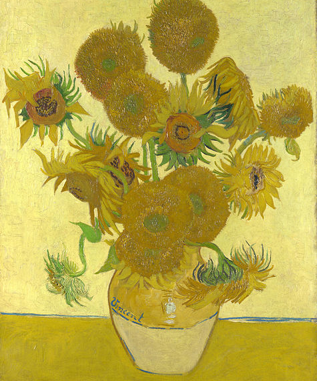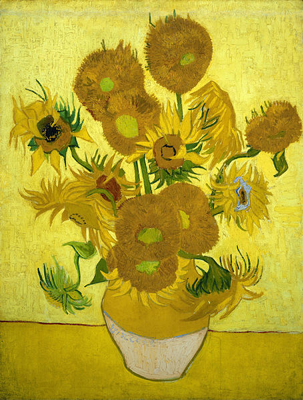
Vincent Van Gogh is a popular fellow. His name might be pronounced incorrectly across much of the world, but pronounced it still is, well over 100 years since his death. His story has everything we want in an artist’s biography. Madness, rejection, devotion, failure, genius, suicide, rediscovery. How many painters have been comforted after an exhibition with the reminder that Vincent only sold one painting whilst he was alive, yet now his paintings are amongst the most expensive in the world? You might as well try and count the stars.
You can count Van Gogh’s extant paintings. Around 900 remain, of which six are versions of his famous Sunflowers. (There were seven but one was destroyed in Japan in World War Two). He did another series of sunflowers earlier, but these Arles Sunflowers are the big boys of his oeuvre. One is in a private collection, the remaining five are usually spread across the world in Munich, Tokyo, London, Philadelphia and Amsterdam.

The National Gallery’s Sunflowers, 1888
However, until 27th April the Amsterdam version has made the trip to London and is being displayed next to its British cousin. That’s right – if you like the Sunflowers then this is your chance to see two versions right next to each other. I’m not sure why this is a good idea, except for playing Spot the difference. There’s a lot of Sunflower-themed toys, bags, objects and costumes for sale in the shop, but no simple Spot the difference game. A definite missed opportunity by the marketing department.
The show is in one room, filled out with X-rays of both pictures and information panels. The London version was painted first, in 1888. The Amsterdam version came slightly later, in 1889 and is a direct repetition of the first painting.

The Van Gogh Museum’s Sunflowers 1889
The construction of the image is still a success. The flowers still twist expressively, the dying and the flourishing still share the same life-giving vase…but the intense colour is gone. Sunflowers is an art history icon and in a well-lit photo it still looks bright, but get up close and – unless you own it or have another vested interest in perpetuating the myth of its magnificence – you’ll see they no longer live up to the hype.
Neither of the Sunflowers we see today remain the same paintings Vincent happily signed centre-stage and hung in Paul Gauguin’s bedroom. Van Gogh described his canvases as ‘a decoration in which the raw and broken chrome yellow will blaze forth.’ No doubt it once did. But paint can fade and the chrome yellow pigment used by Van Gogh has changed colour badly. The yellow is described as that of ‘…happiness and Provence’, but frankly too much of the canvas is now an unattractive brown. Placing the two versions together shows the Amsterdam version to be the more vibrant of the two, painted more quickly as it was copied from the other.
Seen amongst the other paintings in the National Gallery Sunflowers has often given a life-affirming blast. It definitely looked better running free in the wild of the main gallery, amongst the Degas and Manets. Captured and shown with its mate it takes on the melancholy of an animal in a zoo. Putting the two paintings together in a separate low-lit room is one of those seemed-a-good-idea-at-the-time ideas, but they don’t make each other sparkle. Instead the show demonstrates the faded glory of Van Gogh’s most famous works.
NB: The queue to see the Sunflowers can be up to an hour, but I recommend arriving when the gallery opens at 10am. You should be able to breeze straight in. Entry is free.

I’m sure this is true, but it makes me so sad to think that. It always was one of my favourite paintings of all time.
Kind of prophetic in a way the fading glory of a once great work.